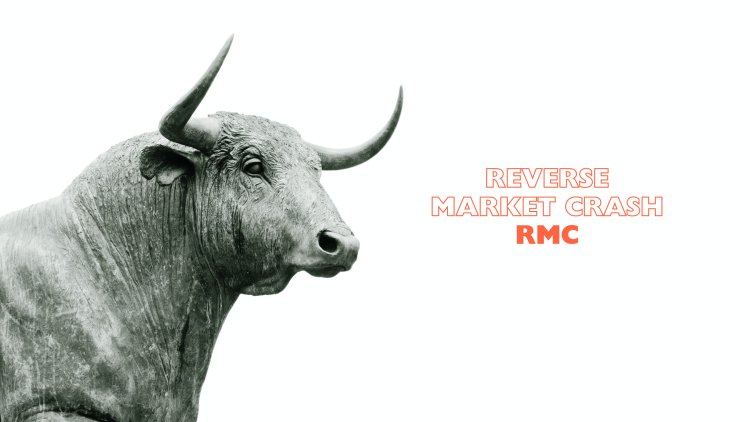Reverse Market Crash
Explore the concept of a reverse market crash, a phenomenon characterized by a rapid surge in asset values, and its implications for wealth distribution and economic stability. Understand the role of interest rates and investment strategies in navigating this unique financial landscape.

Reverse Market Crash
In a nutshell, a reverse market collapse can be described as a sudden surge in asset values, resulting in the affluent getting even wealthier while the less fortunate are left further behind. The phrase "reverse market crash" often goes unnoticed in financial discussions, despite its significant implications for investors and the broader economy. In contrast to the widely recognized scenario of a market collapse marked by a significant drop in asset values, a reverse market crash presents a unique yet equally challenging dynamic.
In light of the recent crash in the reverse market, we must acknowledge the gravity of the situation. The repercussions of this financial downturn are far-reaching and demand our attention.
The recent surge in asset values: A telltale sign of an impending market crash reversal The occurrence of this phenomenon is typically observed when the economy is inundated with an excessive influx of funds, often stemming from interest rate reductions implemented by central banking institutions such as the Federal Reserve. The Impact of Lower Interest Rates: A Double-Edged Sword In the realm of economic policies, few measures hold as much sway as the manipulation of interest rates. Lowering interest rates has long been hailed as a catalyst for economic growth, as it effectively reduces the cost of borrowing. This, in turn, stimulates spending and investment, propelling the wheels of the economy forward. However, as with any powerful tool, there are potential downsides that must be carefully considered.
Undoubtedly, the benefits of reduced interest rates are manifold. By making borrowing more affordable, individuals and businesses are encouraged to take on loans, leading to increased consumption and investment. This surge in economic activity can create a ripple effect, generating job opportunities, boosting consumer confidence, and ultimately fostering a healthier economy. Lower interest rates, therefore, serve as a crucial mechanism for stimulating growth during times of economic stagnation. Nevertheless, it is essential to acknowledge the potential risks associated with this approach. One such concern is opinion. A Spectacle of Prosperity as Stock Markets and Real Estate Values Surge In a remarkable turn of events, both stock markets and real estate values have taken flight, creating an illusion of opulence and prosperity. This captivating display of seeming affluence has captured the attention of investors and onlookers alike.
In today's ever-changing economic landscape, one cannot ignore the significance of the market movement cycle. This cyclical pattern, which has been observed time and again, plays a crucial role in shaping the direction of financial markets and influencing
The Inevitable Phases of Market Cycles: A Closer Look at the Economic Rollercoaster In the ever-fluctuating world of finance, market cycles have long been a subject of fascination and analysis. These cycles, like the ebb and flow of tides, exhibit a predictable pattern that can be observed and studied. By understanding the distinct characteristics that define each phase, investors and economists can gain valuable insights into the dynamics of the market. The first stage, known as accumulation, sets the foundation for the entire cycle. During this period, astute investors identify undervalued assets and gradually accumulate positions. As market participants position themselves for future gains, this phase is characterised by cautious optimism and a sense of opportunity. Following accumulation, the market enters the distribution phase.
Here, the sentiment shifts as investors begin to sell their holdings, taking profits and The Phenomenon of Reverse Market Crashes: A Swift Ascension from the Abyss In the realm of financial markets, crashes are typically associated with a sudden and dramatic decline in asset values, leaving investors in a state of panic and uncertainty. However, there exists a lesser-known phenomenon that defies convention: the reverse market crash. Unlike its more notorious counterpart, this peculiar occurrence is characterised by a rapid and remarkable resurgence in asset values, propelling them from the depths of despair to the realm of accumulation.
While traditional market recoveries often follow a slow and steady trajectory, reverse market crashes defy expectations by swiftly reversing the fortunes of investors. Instead of a gradual climb, these extraordinary events witness a meteoric rise in asset values, defying norms and confounding experts. The distinguishing feature of a reverse market crash lies in its distinctive pattern, where assets swiftly ascend from the bottoming phase to the accumulation period. This remarkable reversal stands in stark contrast to the conventional recovery process, which typically unfolds over an extended period.
As investors grapple with the unpredictability of financial markets, reverse market crashes serve as a reminder that the realm of investments is fraught with surprises. These extraordinary events challenge our understanding of market dynamics and force us to reevaluate our assumptions.
In today's rapidly changing world, it is undeniable that various factors have a profound impact on our socioeconomic landscape. From technological advancements to global events, these influences shape the way we live, work, and interact with one another.
In times of a reverse market crash, it is those who possess substantial assets, including stocks, real estate, and enterprises, who stand to greatly benefit from the sudden surge in asset prices. The Perception of Wealthy Individuals: A Glimpse into Portfolio Growth and Access to Assets In the realm of financial prosperity, the affluent few find themselves basking in the perception of growth within their portfolios, coupled with the undeniable ease of accessing a plethora of assets. This privileged group, with their substantial wealth, experiences a unique vantage point that allows them to witness the flourishing of their investments and effortlessly expand their holdings. For these individuals, the notion of portfolio growth is not merely an abstract concept but a tangible reality.
As they navigate the intricate world of finance, their portfolios Wealth Disparity: A Harsh Reality for the Less Fortunate In a society where economic inequality continues to widen, it is the less fortunate who bear the brunt of this unjust divide. The impoverished, who often possess meagre assets, find themselves trapped in a cycle of financial stagnation, with little to no improvement in their circumstances. This unfortunate reality only serves to exacerbate the already alarming wealth disparity that plagues our nation.
The Squeeze on the Middle Class: Caught Between Rising Consumer Inflation and Soaring Asset Prices In an increasingly challenging economic landscape, the middle class is finding itself in a precarious position. As consumer inflation continues to surge and asset prices reach unprecedented heights, those without real estate or substantial assets are feeling the squeeze like never before. The burden of rising consumer inflation is weighing heavily on the middle class. Everyday essentials, from groceries to healthcare, are becoming increasingly expensive, eroding the purchasing power of hardworking individuals and families.
As prices soar, the middle class is forced to stretch their budgets to the limit, struggling to maintain their standard of living. Compounding this financial strain is the skyrocketing cost of assets, which poses a significant challenge for those without real estate or substantial investments. As property values surge and stock markets reach new highs, the middle class finds itself excluded from the benefits of these wealth-building opportunities. Without a foothold in the real estate market or significant assets to leverage, they are left on the sidelines.
Interest Rates: The Key Determinant In the realm of economics, few factors hold as much sway over the financial landscape as interest rates. These seemingly innocuous digits have the power to shape the trajectory of entire economies, influencing everything from consumer spending to business investments. Indeed, it is no exaggeration to
The pivotal role of interest rates in maintaining economic stability and curbing inflation cannot be overstated. The Decline: A Catalyst for Lopsided Wealth Distribution and Soaring Asset Values The Federal Reserve's Interest Rate Reduction: A Potential Catalyst for Widening the Wealth Gap In a move that could have far-reaching consequences, the Federal Reserve is contemplating a significant reduction in interest rates. While such a decision may seem beneficial at first glance, it is crucial to carefully consider the potential ramifications it could have on the housing market and the already troubling wealth disparity. One of the most concerning outcomes of a substantial interest rate cut is the potential surge in property prices. A
s interest rates decrease, borrowing becomes more affordable, enticing buyers to enter the market. However, this increased demand could lead to a troubling scenario where property prices skyrocket beyond the reach of average homebuyers. The consequences of such a development would be dire, exacerbating the already alarming wealth gap that plagues our society. As property prices soar, those with substantial financial resources will be better positioned to capitalize on the market, further widening the divide between the haves and have-nots. The implications of an inflated housing market extend beyond mere financial inequality. Access to affordable housing is a fundamental right that should be safeguarded for all members of society.
However, if interest rates are drastically reduced without proper precautions, this essential right could be jeopardized, leaving countless individuals and families struggling to secure suitable housing. It is imperative that policymakers and the Federal Reserve exercise prudence and foresight when considering any significant changes to interest rates. While
In these tumultuous times, we must navigate the rough waters with resilience and determination. The challenges we face may be daunting, but we must remain steadfast in our pursuit of progress and stability.
In light of the potential for a reverse market crash, investors must equip themselves with knowledge and exercise prudence in their decision-making. Diversification of investment portfolios through the inclusion of tangible assets, such as land, could prove to be a prudent move. The enduring value of land: a wise investment choice When it comes to investments, one option stands out for its ability to retain its intrinsic worth over time: land.
Unlike stocks or constructed real estate, land possesses a unique quality that makes it a reliable asset in any portfolio. Its versatility offers a multitude of possibilities, ranging from future development prospects to agricultural utilisation. Unlike the volatile nature of stocks, where market fluctuations can cause significant losses, land remains steadfast in its value. Regardless of economic conditions or market trends, the worth of land endures, providing a stable foundation for investors. This inherent stability makes land an attractive choice for those seeking long-term financial security. Moreover, land offers a range of alternatives that further enhance its appeal.
One such option is future development. As urban areas expand and populations grow, the demand for land for residential, commercial, and industrial purposes increases. Investing in land with development potential can yield substantial returns as the need for space escalates. The potential for capital appreciation in such cases is undeniable. Additionally, land can be used for agricultural purposes, presenting yet another avenue for investment. With the world's population steadily rising, the demand for food and agricultural products continues to soar. Investing in land The Importance of Acting as a Buffer Against Inflation and Providing Long-Term Stability
In a concise summary, the following points can be gleaned from the user's text:.
Navigating the Difficult Financial Environment That The Reverse Market Meltdown Created To safeguard their financial well-being, individuals and investors must prioritize being well-informed, seeking expert advice, and taking proactive steps to address the unique challenges posed by this phenomenon.
Editorial Disclaimer: This article serves solely as an informative piece and should not be misconstrued as financial advice. Seeking advice from a financial expert is imperative before embarking on any consequential financial endeavors. In light of the diverse financial circumstances that individuals face, it is crucial to recognize that what may prove effective for one person may not necessarily be suitable for another.
Thanks for reading



 admin
admin 










